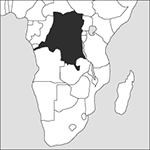
Capital:
Kinshasa
Area:
2,344,858 sq km (905,355 sq miles)
Population:
75,507,308 (2012 est)
Currency:
1 Congo franc = 100 centimes
Religions:
Roman Catholic 50.0%; Protestant 20.0%; indigenous Christian 10.0%; Muslim 10.0%
Ethnic groups:
Luba, Kongo, Mongo, and Mangbetu-Azande: about 45%; over 200 other groups, including Rwanda, Bangi, Ngale, Rundi, Teke, Boa, Chokwe, Lugbara, and Banda
Languages:
French (official); Lingala; Kingwana; Kikongo; Tshiluba; local languages
International Organizations:
UN; AU; Non-Aligned Movement; Franc Zone; SADC; WTO
(name from 1971–1997 Zaïre) The largest country in equatorial Africa; it is bounded by nine other countries and has an outlet to the Atlantic Ocean at the mouth of the Congo.
Physical
Thick forests cover the central districts and there is much swamp. In the south, however, are open highlands. The eastern boundary runs down the Great Rift Valley and includes the western shore of Lake Tanganyika.
Economy
The country has substantial agricultural, mineral, and energy resources, whose development has been impeded by corruption, smuggling, lack of infrastructure and investment, as well as civil war (1996–2003) and subsequent instability. The main exports are cobalt, diamonds, copper, gold, zinc, coltan, wood products, crude oil, and coffee. Other than coffee, agriculture includes sugar, palm oil, tea, cocoa, and rubber. Industry includes mining and mineral processing, consumer goods, and metal products. In spite of its mineral wealth it is one of the very poorest countries in the world.
History
The pre-colonial 19th-century history of the country was dominated by the Arab slave trade. Livingstone was the first European explorer of the country. In 1871 Stanley undertook to sail down the River Congo. His reports prompted King Leopold II of Belgium to found the International Association of the Congo (called the Congo Free State from 1885). Stanley began to open up its resources. Maladministration by Leopold’s agents obliged him to hand the state over to the Belgian Parliament (1908), and it was renamed the Belgian Congo, but in the next 50 years little was done, except by Catholic mission schools, to prepare the country for self-government. The outbreak of unrest in 1959 led to the hasty granting of independence in the following year, but the regime of Patrice Lumumba was undermined by civil war, and disorder in the newly named Democratic Republic of Congo remained endemic until the coup of General Mobutu Sese Seko in 1965. In 1967 the Union Minière, the largest copper-mining company, was nationalized and Mobutu achieved some measure of economic recovery. In 1971 the name of the country was changed to Zaïre. Falling copper prices and centralized policies undermined foreign business confidence, and two revolts followed in 1977 and 1978 in the province of Shaba (formerly Katanga), only put down with French military assistance. The 1980 constitution only recognized one political party, the Movement Populaire de la Révolution (MPR), and Mobutu was re-elected as sole candidate in 1977 and 1984. Multiparty elections were promised for 1991, during which the five main opposition parties all refused to support the President’s nominated Prime Minister. Near economic collapse provoked riots, looting, and arson. In a confused situation, Mobutu cancelled elections for a renewal of his term of office in December 1991. During 1992 a national constitutional conference was convened and this replaced the government with a High Council of the Republic. Political instability continued with the President and the High Council appointing rival cabinets. An agreement was reached in 1994, when both cabinets were replaced by a new transitional legislature. The country’s social and economic problems were, however, increased with the influx of over 1 million refugees from the civil war in neighbouring Rwanda. In August 1995, Zaïrean troops began the forcible repatriation of Rwandan refugees; however, after international condemnation, this policy was halted the following month. In April 1996 Hutu militiamen and Zaïrean soldiers launched a pogrom against Tutsis in Zaïre, driving hundreds of refugees into Rwanda. This led to civil war, with Zaïrean Tutsi rebels attacking government troops and gradually taking over more of the country. By June 1997 Mobutu fled, the rebels’ leader, Laurent Kabila, became president, and the country reverted to its former name. The civil war continued during Kabila’s rule; he was killed during an abortive coup in 2001 and succeeded by his son, Joseph Kabila. A transitional government that included the main rebel groups as well as the Kabila regime was established in 2003. The legislature approved a new constitution in 2005 and this was subsequently backed in a referendum; it came into force in 2006 and Kabila was elected President. An agreement to bring peace to the eastern Congo was signed in 2008. Despite military operations by Congolese and Rwandan forces, unrest continues in the east. Kabila was re-elected as President in 2011 in a disputed election. He should have stepped down in November 2016 but his presidency has been extended to 2018, against much opposition, while voter lists are updated.
- multiplication law for probabilities
- multiplication modulo n
- multiplication(of complex numbers)
- multiplication(of fractions)
- multiplication(of matrices)
- multiplication(of polynomials)
- multiplication(of real numbers)
- multiplication sign
- multiplicative group
- multiplicative identity
- multiplicative inverse
- multiplicity
- multiplier
- multiplier–accelerator model
- multiply connected
- multiplying factor(in differential equations)
- multiply out
- multipoint connection
- multipoint line
- multipoint video conferencing
- multipolar neuron
- multipole expansion
- multipole interactions
- multiport memory
- multiprecision